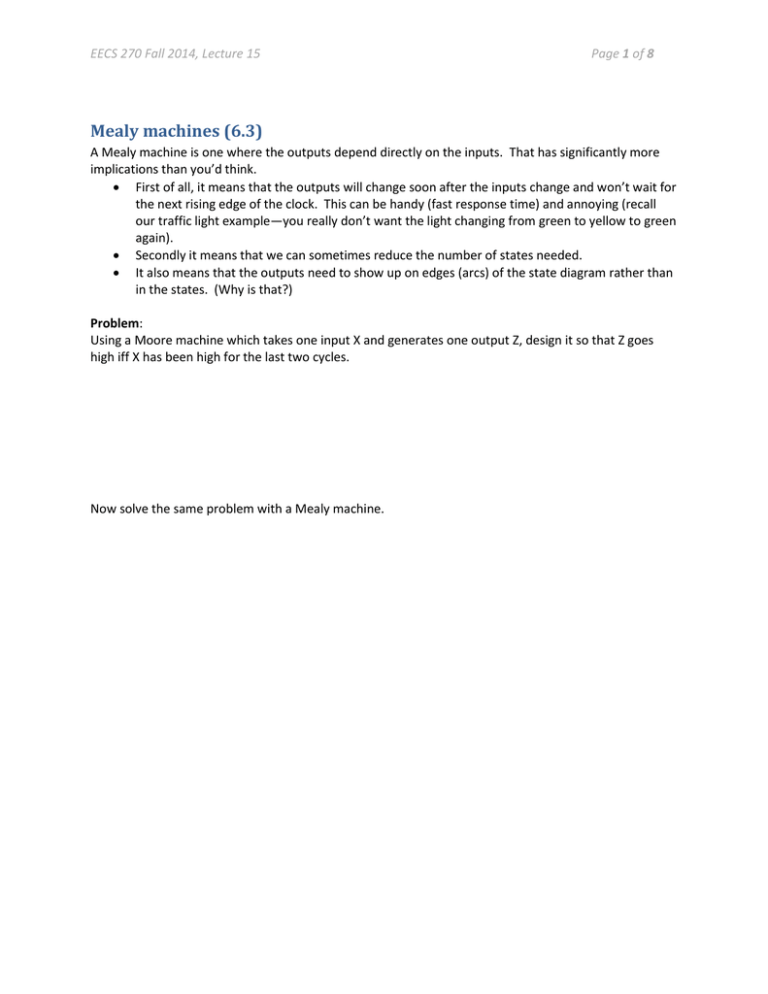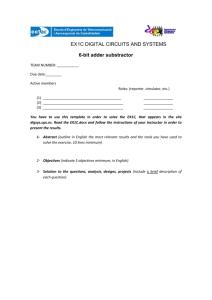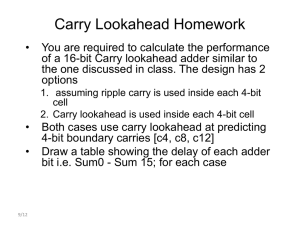docx
advertisement

EECS 270 Fall 2014, Lecture 15 Page 1 of 8 Mealy machines (6.3) A Mealy machine is one where the outputs depend directly on the inputs. That has significantly more implications than you’d think. First of all, it means that the outputs will change soon after the inputs change and won’t wait for the next rising edge of the clock. This can be handy (fast response time) and annoying (recall our traffic light example—you really don’t want the light changing from green to yellow to green again). Secondly it means that we can sometimes reduce the number of states needed. It also means that the outputs need to show up on edges (arcs) of the state diagram rather than in the states. (Why is that?) Problem: Using a Moore machine which takes one input X and generates one output Z, design it so that Z goes high iff X has been high for the last two cycles. Now solve the same problem with a Mealy machine. EECS 270 Fall 2014, Lecture 15 Now, let’s look at the timing diagram associated with each machine. Moore: CLK X State Z Mealy: CLK X State Z Page 2 of 8 EECS 270 Fall 2014, Lecture 15 Page 3 of 8 Faster adders (3.4) Ripple-carry adders are slow. How many gate delays do we have for a 4-bit adder (in the worst case)? For a 32-bit adder? They are however pretty small. (How many gates for a 32-bit adder?) Can’t we just use sum-of-products for the 4-bit adder? What would be our gate delay? How big would it be? Do the same thing for 32-bits. What if we are limited to 2-input gates? However the look-ahead logic gets really ugly really quickly. We _could_ stop at 4 and ripple from there. EECS 270 Fall 2014, Lecture 15 In any case, let’s try something smarter. Page 4 of 8 EECS 270 Fall 2014, Lecture 15 Page 5 of 8 EECS 270 Fall 2014, Lecture 15 Page 6 of 8 Analysis of our 4-bit CLA compared to a RCA Performing a fair comparison between two architectures can be surprisingly difficult. The difficulty lies in what assumptions we make. Let’s go through two models. #1 Gates-are-gates model Here we’ll charge just as much for a 20-input gate as a 2-input gate. This is of course very unrealistic, but has the advantage of being easy. So let’s count total number of gates in both and worst-case delay (again, assuming all gates are equal). Adder type (4-bit) RCA CLA Gate count Gate delays #2 “Reasonable” gate scaling Here for count we’ll charge each gate an amount equal to the number of inputs it has. So a 3-input OR gate costs 3 and a 2-input XOR gate costs 2. But for delay we’ll charge log2(inputs). So 1 input is free, 2inputs costs 1, 3 inputs is 1.5 (okay, 1.58 but let it go), 4 inputs is 2, 5 inputs is 2.25 (2.3) and 6 inputs is 2.5 (2.6). Adder type (4-bit) RCA CLA Gate-input count Log2(gate-input) delays What is your conclusion about these two schemes? EECS 270 Fall 2014, Lecture 15 Page 7 of 8 Bigger than 4 bits? OK, it seems that this will start to get ugly past 4 bits. How could we build a 16-bit adder? Ripple-carry (again) One obvious way is to just ripple the carry. What is the delay and count for each of the two schemes? Adder type (16-bit) RCA Gate count Gate delays Adder type (16-bit) Gate-input count Log2(gate-input) delays RCA CLA CLA EECS 270 Fall 2014, Lecture 15 Page 8 of 8 Carry-lookahead (again) Or we could try to get tricky. Obviously (?), we could use the lookahead logic again. Adder type (16-bit) Gate count Gate delays Adder type (16-bit) Gate-input count Log2(gate-input) delays CLA CLA Of course, we have another option: 2-level logic It turns out counting the number of gates for the 2-level adder is pretty hard. But here’s a graph (figure 4.24 from the text) that shows the number of transistors needed. It’s a case of exponential growth, so a 32-bit adder needs something like 200-billion transistors (a modern CPU has about 1 billion)... In any case, or 4-bit 2level adder needs about 100 gates. What do you estimate delay will be for a 4-input adder using our log model for delay? ____________________________





